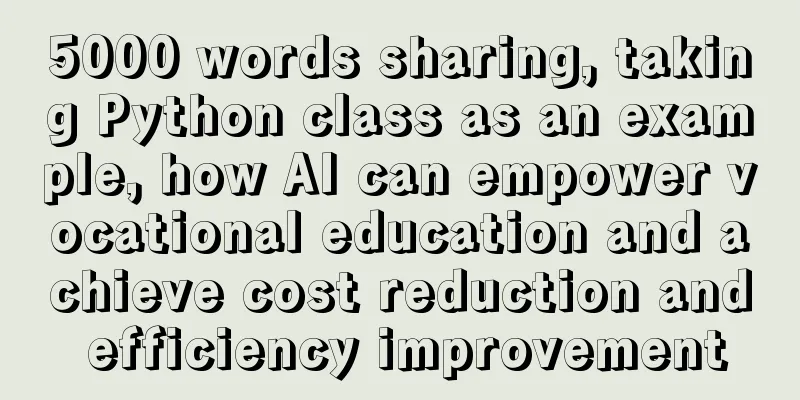5000 words sharing, taking Python class as an example, how AI can empower vocational education and achieve cost reduction and efficiency improvement

I have been deeply researching online education projects recently. Below I would like to share with you some of my recent thoughts using a practical case! I. Basic Situation of Vocational EducationAccording to statistics, vocational education has trained and supplied more than 200 million workers to various industries in my country, accounting for 26% of the total employment, making a huge contribution to the sustained and rapid development of my country's economy. With the implementation of the double reduction policy, many K12 education giants quickly adjusted their course and began to focus on the vocational education sector. Unlike the K12 industry, which has been subject to heavy regulation, vocational education has always been supported by policies in my country. This industry, which closely follows the general direction of the policy, has also become a real golden track. As the main force in talent cultivation, vocational education has huge room for industry development. This fast lane with "many cars and many people" is becoming more and more crowded, and the competition for students is becoming increasingly fierce. Faced with problems such as high customer acquisition costs, confusing user data, difficulty in renewing classes, and low referral rates, educational and training institutions are under soaring pressure to increase users. At the same time, vocational education courses generally have a high unit price, user decision-making, high costs, and it is difficult to pay in a short period of time. Therefore, it is even more necessary to continue to plant grass through public domain + private domain operations and ultimately incubate transactions. The above is some basic information about vocational education. Next, I will take a vocational education course as an example to share how AI empowers the vocational education track in this business and solves the growth problems in the entire domain, as well as how I think in this process. 2. Product user positioning and global traffic diversion1. Product Background InformationThis case is mainly based on the python crawler training course, and its main selling point is: high starting salary, which is favored by major companies, and the average customer unit price is between 3,000 and 8,000. Target group: Age: 20-28 years old Occupation: 1-5 years in the workplace, online college students Target user description: want to improve additional skills, have a desire to learn, are interested in crawlers, have a need to use them in daily work, may be hesitant, and want to learn the basics first. After having a rough understanding of the user group portrait, you can draw a user path map based on public platforms and existing private resources and touchpoints, and gradually break down the core elements of each link. Let’s take stock of and analyze the data, whether it is online education or knowledge payment. Final revenue = number of paying customers * price Number of paying users = total number of users participating in the experience * proportion of people who are aware of the product * proportion of people who are interested * proportion of people who have intention * proportion of people who can afford the price. You will find that this is also a funnel model in itself. Therefore, in this business model, the front-end traffic determines the number of user participants; the subsequent funnel conversion ratio is improved by operational means. And an effective operational means must be replicable. Since it can be replicated, AI can definitely intervene to help improve efficiency. Combining the business roadmap and business decomposition formula, I listed the following questions (there are more actual questions, shown in the display section): (1) Public domain traffic diversion, dormant activation and micro-channeling
(2) After adding WeChat, you will be guided to attend live classes or trial classes
(3) Guiding conversion after taking the experience class
(4) Continuous seeding strategy for unconverted users
2. Role and purpose of each platformBefore that, I sorted out the various traffic contact points of each platform, and finally selected the above core platforms that are suitable for this business. You can sort them according to your own business. Finally, the following major platforms were selected:
Corporate WeChat account: course consultant, career planning, course introduction, intention screening, and sales conversion. 3. AI empowers private domain precipitation and conversionAfter taking inventory of all the touch points of the core platform, combined with the user path of the entire business, AI capabilities are implanted into each link to truly achieve efficient and automated private domain traffic sedimentation. Here’s how to do it: 1. Public domain traffic diversionOn platforms such as Douyin, Kuaishou, and Video Account, a low-priced trial course is launched online, such as 1 yuan, 9.9 yuan, 19.9 yuan, etc., or even free. (I personally recommend the form of low-price payment, which can screen out some of the people who are trying to get the wool and find more accurate users.) The ultimate core goal is to be able to obtain the user's mobile phone number on the public domain platform. Then, through the form of AI phone calls, the AI phone robot will automatically call these users in the form of simulating a real person, and tell them that they have placed an order for a course on the XX platform. Now our course teacher has sent you a text message. Remember to add the teacher’s WeChat. The teacher can provide you with targeted one-on-one tutoring, and there are also additional limited benefits to be received. 2. Other ways to divert traffic to the public domainWe also considered other methods at the time, such as listing high-quality course materials, supporting tools, CDs, etc. on public platforms and selling them at low prices. Then, in the materials, we embedded QR codes for adding professional teachers for guidance. We could also use AI phones to provide automated telephone communication for users who have not been added (but due to resource issues, this method was not ultimately used). In this way, all users on the public platform are deposited into the private domain as much as possible. It is worth noting that the higher the payment, the higher the overall rate of adding micro-users after the connection. The rate of adding micro-users for a 99-yuan course can be close to 90%. Similarly, the cheaper, or even free, the lower the rate of adding micro-users. 4. Activate dormant users in the CRM databaseAlmost all online education companies have a large number of users in their CRM database. And since the users in the CRM database are basically users who have consulted related courses before, the only information they have is their mobile phone number and consulting information. Of course, this batch of resources should not be wasted. According to the courses they consulted and the needs of the research, we also make outbound calls through AI phones, offering them courses, gifts, free trials, one-on-one consultations and other benefits to attract target users, and then use the smart SMS function in the AI phone to send SMS to those users who are interested (saving the SMS costs of some non-interested users). This can also wake up some of the interested users. 1. Entering the private domain for the first time (specifically WeChat for Business)After entering WeChat for Business, the AI robot of WeChat for Business can automatically chat with users to obtain user information and needs, and automatically change notes and add keyword tags. For example, you can automatically send the following types of messages to users:
2. Conversion strategies in private domains1V1+community+friend circle+live broadcast, fully automatic reach, replicating the best practices of the strongest sales. The key to switching from low-priced courses to formal courses is to get users to actually attend the course and to implant in the course a beautiful imagination of what they will experience after completing the course. Therefore, AI will remind and interact with users before, during, and after the course based on whether they attend the course as planned during the low-priced trial course cycle. In the circle of friends, push relevant content to promote the formal course for the tags of this batch of low-priced trial courses. Constantly share various kinds of pain before class and beautiful pictures after class, such as real user feedback on promotion and salary increase. Based on the feedback from the class data, sales will prioritize communicating with users who have attended classes for a long time but have not converted, and let AI contact the remaining users. If they have not converted in the end, they will be invited to attend a live class with a real person, and the teacher will convert them in the live room. According to the test results, half of the users who finally converted were generated in the community during the training camp, and the other half were generated in the live room after the end of the training camp. Note that AI can also automate the interaction of social media users in the community, creating a very active and lively atmosphere. The core of AI empowerment is to solve the problem of standardization, so that human time and energy can be focused on core users who are likely to be converted, thereby maximizing resource efficiency. 5. AI assists in daily user management and operation1. Content seedingBased on the user portraits above, we need to understand clearly what pain points and needs users in different user life cycles have. For example, new users (who have not actually taken the trial course):
The core output content can have the following directions:
With these content frameworks, copywriters will have a clear direction. They can then develop a content plan based on user life cycles and weeks, and automatically push content based on the tags. As long as the content provided is valuable, even if users do not come to class at the beginning, or do not convert after class, continuous promotion will still attract some users to come back and then reconsider conversion. Similarly, the communication and interaction between communities and 1V1 also follows the same logic. A fully automated SOP process should be designed to allow AI to automatically reach out to users based on their data and behavior. 2. Content DistributionThe underlying logic of content distribution is still user tags. Based on this business, the initial tags can be:
These four types of crowd labels, and then set up different content reach tests according to different user labels, and use the 1V1+community+friend circle, and SMS+AI phone on corporate WeChat as a whole. Such as SOP for various scenarios 3. Activity conversionGenerally speaking, it is difficult to achieve direct conversion in adult courses, so we have to have the short-term training camp course method mentioned above, the purpose of which is to allow users to experience the course and ultimately form conversions. But if a short-term training camp does not lead to conversion, we cannot give up. We can set up various forms of activities, think of various reasons to communicate with users, and invite them to experience conversion. For example: Training Camp: Set up training camps related to various thematic courses based on a series of problems that Python courses can solve; Live class: We plan live courses on various topics at various time stages. For example, when doing a review and summary at the end of the year, how to quickly get data; when doing performance and salary settlement at the end of the month, how to use Python to process data; how to crawl the entire network for data analysis, etc. Promotions: Use festivals to launch promotions, and combine them with flash communities, group buying, and flash sales to select high-potential customers for conversion; Daily content conversion: That is, using methods such as WeChat Moments, 1V1, and communities to attract conversions. All strategies have cycles and plans. According to this logic, you can set up a monthly activity plan, use AI capabilities to gradually design the best SOP, and then use AI to achieve automated reach. Finally, continue to review, iterate and optimize the SOP next month, and continuously optimize the business data model to truly maximize business value. 6. Cognitive Accumulation and Business ReplicationThe methodology and way of thinking can be refined and applied to other products, because SOP is dead, but the underlying principles remain unchanged. 1. AI empowers global traffic diversionRegardless of the industry, as long as you get a mobile phone number on a public platform, you can use AI calls to simulate real people and invite users to actively add the brand's WeChat. We have tested multiple forms and conversion rates in different user life cycles. 2. AI empowers private domain conversion and activationIn the private domain scenario, if you want to convert transaction users and keep users active, you need to create a personal IP, combine the personal positioning of the IP, output a large amount of content and periodic activities, and continue to communicate with users. Whether it is 1V1, social group, or circle of friends. When you have hundreds of thousands or even millions of private domain users, you may have hundreds of corporate WeChat accounts. If it is entirely dependent on human interaction and communication, no matter what their abilities are, a service team of at least 50, 60 or even 100 people will be needed. The salary and management of so many people alone will be extremely costly, and whether employees of different qualities can truly serve customers will also be a big problem. However, if AI is used, a service team of only about 10 people may be needed, with a set of continuously iterated SOP mechanisms, so that AI can complete the work of more than 100 people in the past, and the main work of humans is to solve the problems that AI cannot answer, and optimize the ability of iterative AI. The remaining 9/10 of the labor cost can improve the service efficiency by 10 times. 3. AI empowers user lifecycle managementIn the private domain, few people can truly establish a user life cycle. The core difficulty is that we don’t know when the user added us as a friend, what we have contacted with after adding us, what actions we have taken, what products we have bought, how many times we have bought, and when we bought them. Therefore, it is necessary to use a SCRM system to synchronize each user's attributes, behaviors, preferences and other information to the enterprise WeChat in the form of tags. Then AI will automatically trigger the push content based on these tags to guide users into the next life cycle. For example, Luckin Coffee will push coupons of different amounts to you after adding you as a friend, depending on whether you have made purchases on their platform. Then, seeing that you have not made any purchases for a long time, they will continue to increase the discounts to a minimum of 45% off, and then, after you use the coupons to make a purchase, they will start to reduce the discounts until you keep making purchases. All of this is the result of AI combined with big data to automatically manage the user lifecycle. Among them, we tested the AI phone with the strongest reach, and the corresponding data results in different user life cycles are for reference. at lastThese are just some basic ways of using AI in digital marketing. With the popularity of chat GPT, I believe there will be more intelligent operations in actual business scenarios. In the past few years, you may not have heard of this, but it turns out that you can do business this way! As a result, many people may lose their jobs, because AI can do everything they can do, and it can do it better! This is the world we live in. It changes so fast that we can no longer recognize it. There are so many confusions and hurts. A speck of dust from the times is like a mountain when it falls on everyone. What should we do? Only by continuous learning and iteration can we do things that AI cannot do! Let’s encourage each other! Author: swimming, WeChat public account: Growth Leader (ID: swimming54) |
<<: Is there a promising future for the toy business?
>>: Two models to explain the development of new pet brands from 0 to 1
Recommend
A brief history of CEO live streaming in China
The birth of the Internet PR industry is closely r...
How do Lazada buyers apply for returns? How to deal with malicious returns?
Nowadays, cross-border e-commerce is a business pa...
Where is the eBay video authentication? What should I do if the eBay video authentication does not have a landline number?
With the increasing popularity of online shopping,...
How often are Amazon account ratings updated? Why do Amazon rankings drop?
For Amazon merchants, there are many things that n...
With a revenue of 6.2 billion in 3 months and a joint venture with Moutai that went viral, how did Niuhulu Luckin Coffee become successful?
This article first briefly introduces the joint ve...
Is there any risk in helping others register for Amazon? What are the potential risks?
There are many advertisements now that offer to he...
Douyin's "blind box" has become more and more popular with 4 million fans in 3 months
Have you ever opened a blind box? The most attract...
Station B terminates its decision to completely cancel the display of playback data
Yesterday, Bilibili announced the termination of i...
New consumption has lowered its profile, and popular brands are moving towards high-end?
With the changes in the current consumer environme...
Is Shopee Philippines easy to operate? How is the e-commerce environment?
As we all know, the first sites that Shopee platfo...
What are the interview tips for Alibaba International Station account manager?
Many people are optimistic about cross-border e-co...
What are the characteristics of Amazon Australia? Introduction
By analyzing the data on Australia's cross-bor...
How can a complete amateur become a Xiaohongshu blogger? 3 tips from my recent experience in blogging!
The content of this article comprehensively and sy...
B Station e-commerce must pass three tests
Nowadays, all platforms are involved in e-commerce...
Is it easy to work as an Amazon Japanese operator? What does the job involve?
It is not an easy task to operate an online store,...









